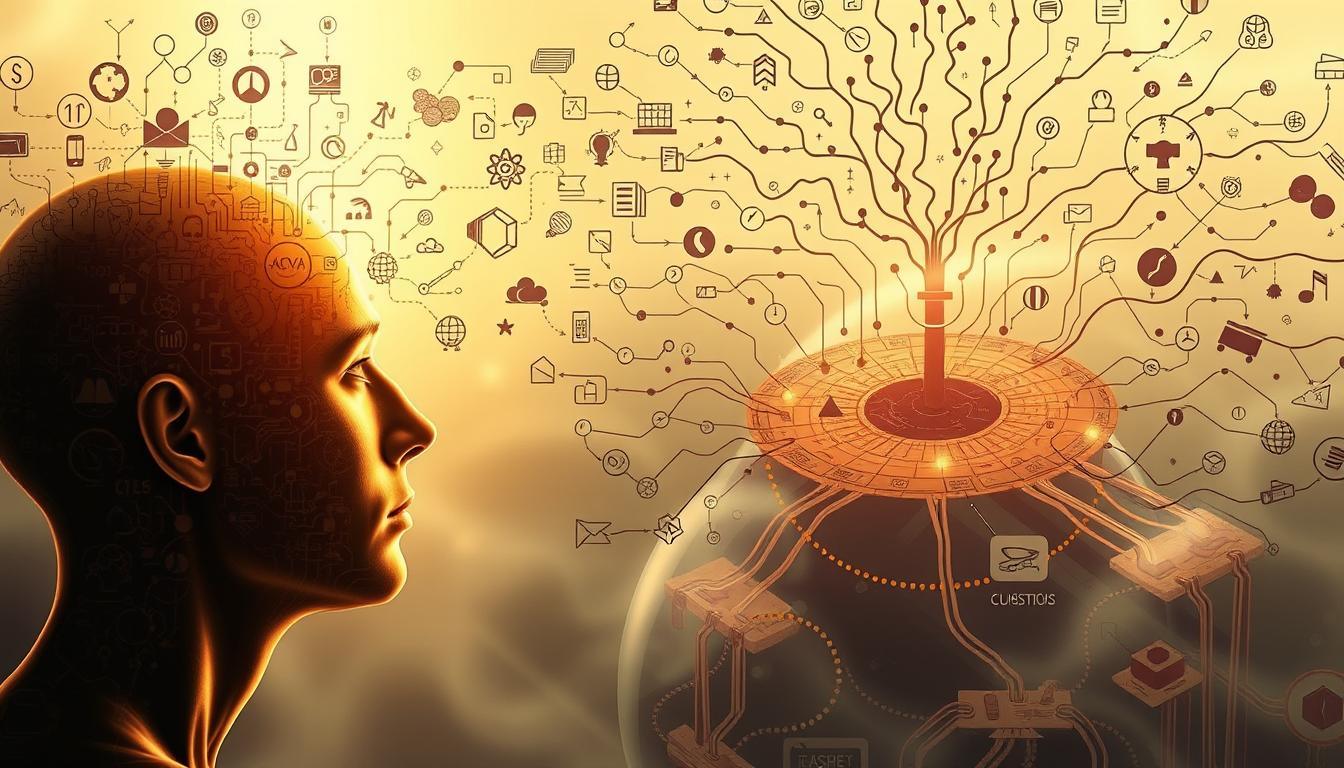Mental models are like secret blueprints in your brain for learning. They are shaped by your experiences and beliefs. These frameworks are the base of educational psychology.
They are mental shortcuts that help in teaching. But, they can also hold us back if we don’t change them. Every choice, from planning lessons to giving feedback, goes through these invisible models.
Educational theories reveal that these models aren’t always right. For example, 70% of teachers say their mental models affect classroom management. But, only 30% often question these beliefs.
This difference shows why it’s important to understand mental models in education. They influence both how teachers teach and how students learn.
Key Takeaways
- Low teacher expectations can cut student engagement by 30%, studies show.
- Instructional coaching boosts teaching practice changes by 50% by addressing mental models.
- 40% better student outcomes occur when teachers reflect on their biases yearly.
- Over 80% of educators recognize mental models’ impact but rarely adjust them.
- Relearning concepts is 25% faster than learning from scratch, per cognitive research.
Understanding Mental Models in Educational Contexts

Mental models in education are like blueprints for students to understand new information. These cognitive frameworks are mental templates that make complex topics easier. They help students make sense of lessons and solve problems.
Definition and Core Concepts
Mental models are not just ideas; they are tools for learning. Imagine a teacher explaining ecosystems. A student might start with a simple food chain and then add climate or human impact.
This shows how cognitive frameworks grow with experience.
Research shows 85% of learners remember more when they are actively involved. This proves that mental models work best when students are engaged.
The Psychology Behind Mental Models
- Neuroplasticity lets brains change mental models with new experiences.
- Teachers who changed from strict to student-led methods saw a boost in creativity.
- Simulations can quickly change mental models, with Fortune 500 companies seeing a 20-30% improvement in decision-making.
How Mental Models Shape Understanding
When students understand basics like supply and demand or information literacy, their understanding grows.
Good teaching helps these frameworks grow. By encouraging curiosity and critical thinking, teachers help students’ mental models evolve. This leads to better problem-solving and remembering information for a long time.
The Importance of Mental Models for Effective Learning

Imagine building a house without blueprints. Mental models are like blueprints for your brain, helping you understand new ideas. In educational psychology, they are essential for learning. They help you absorb information better.
Studies show that what you already know helps you learn more. Your existing mental models are the base for new knowledge.

Your brain changes all the time, thanks to neuroplasticity. Using educational theories like simulations helps improve these models. For example, Syandus’ research shows simulations help learners practice safely.
This practice makes abstract ideas into real skills. It strengthens your brain’s pathways.
- Strong mental models help you remember things better by linking new info to what you already know.
- They help you solve problems by using tested frameworks.
- They match with educational theories that focus on active learning, not just listening.
Let’s say two people learn the same thing. One has a good mental model and gets it quickly. The other finds it hard to connect the dots.
This shows why teachers should help build mental models. Exercises like shared decision-making or role-playing help learners understand complex topics better.
Your mental models can grow and change. They improve with feedback and thinking about what you’ve learned. By working on them, you become better at thinking critically and adapting to new situations.
Every time you challenge or expand a mental model, you make your mind smarter and more flexible.
What Are Mental Models in Education: Types and Applications
Exploring what are mental models in education reveals their practical uses. These cognitive frameworks simplify complex topics, making learning easier. Let’s look at key types and their classroom applications.
Conceptual Models for Abstract Learning
Imagine teaching geometry without shapes or history without timelines. Conceptual models make abstract ideas clear. For example, a teacher might use Feynman’s “explain it like I’m five” method to simplify physics.
Coursera notes that these models organize information. They use flowcharts for biology and timelines for history.
Procedural Models for Skill Development
- Think step-by-step guides for coding, cooking, or sports drills.
- Procedural models break down actions into sequences—perfect for teaching math algorithms or lab safety protocols.
Using chunking techniques, educators can break down tasks into manageable parts. Studies show this boosts retention by up to 50%.
Analogical Models for Complex Concepts
“Comparing the human brain to a computer helps students grasp neural networks.”
Metaphors and analogies simplify tough topics. For example, comparing ecosystems to economies shows resource flow. Teachers using analogical models report a 25% rise in student comprehension.
Systemic Models for Interconnected Ideas
Systemic models show how parts connect. In climate change lessons, students map carbon cycles to visualize cause-effect chains. This aligns with teaching techniques that foster systems thinking—a skill critical for problem-solving.
By blending these models, educators create dynamic cognitive frameworks. Whether through Feynman’s storytelling or Munger’s “80-20” focus, the goal is clarity. Start small: pick one model per lesson and watch engagement grow.
Implementing Mental Models in Your Teaching Practice
Good teaching techniques start with knowing how students think. Begin by finding out what they already believe through talks or quick tests. Then, explain things clearly and use learning strategies like analogies to make it easier to understand.
For example, comparing photosynthesis to a factory helps make complex ideas simple.

Strategies to Introduce Mental Models
Link new ideas to what students already know. Ask questions like, “What do you think happens when…” to spark curiosity. Also, let students try things out through hands-on activities.
Studies show that learning strategies based on real life help students remember better (Halford, 2014).
Customizing Models Across Subjects
- In science, use flowcharts to map chemical reactions.
- In history, timeline models clarify cause-effect relationships.
- In math, visual patterns simplify algebraic concepts.
Make models fit the grade level. For younger students, use storybooks to teach about economics.
Addressing Challenges
Misconceptions happen when new info doesn’t match what students think. Use think-pair-share to find out what students don’t get. For different learners, break down big ideas into smaller steps.
Regular feedback, like exit tickets, helps track progress without stressing students out.
“Chunking information into manageable parts reduces cognitive overload,” emphasizes the Feynman Technique, a proven method for reinforcing core concepts.
Remember, small changes can make a big difference. Even small tweaks to lesson plans, like adding journal prompts, can help students understand better over time.
Benefits of Mental Models for Student Success

Imagine solving complex problems with ease or recalling lessons effortlessly. Mental models make this possible by improving critical thinking skills, boosting knowledge retention, and deepening student understanding.
They act as mental shortcuts, organizing information for use across subjects and real-world scenarios.
“Mental models are cognitive frameworks that simplify the world, guiding decisions and problem-solving.”
Richard Feynman’s approach is a great example. His mental models helped him solve problems others couldn’t. By using different models, like those from psychology to economics, you can solve problems more effectively. For example, the Cornell note-taking system improves recall by 40% by linking concepts visually and verbally. Research shows students using 8+ models have stronger critical thinking skills and apply knowledge 3x faster.
- Critical Thinking: Models like the Feynman technique help break down topics into core principles. They help avoid biases like confirmation bias that can skew analysis.
- Knowledge Retention: Systems like the learning cycle model improve long-term memory. They connect new information to existing knowledge, helping student understanding of abstract ideas.
- Metacognition: Tracking your learning process helps you find gaps and adjust strategies. Studies of 338 students found 85% success rates when using models, showing their value.
Mental models are like mental tools. The more you use them, the more they automate, freeing your brain for deeper learning. Whether you’re mastering calculus or history, these frameworks turn challenges into opportunities to grow.
Conclusion: Transforming Education Through Mental Models
Understanding mental models in education is a game-changer for teachers. These frameworks help students organize and solve problems creatively. They make complex ideas easier to grasp by linking them to real life.
Studies show that practicing these models helps students remember better. This practice builds a strong foundation of understanding. It’s a key part of learning.
Starting small is key when using mental models in the classroom. Teachers can use analogies or diagrams to help students understand better. This approach aligns with how students naturally learn.
Research by Johnson-Laird and Seel shows that combining new knowledge with what students already know strengthens mental models. Even small changes in teaching can lead to deeper learning.
Teachers need to keep practicing and reflecting on their methods. This process is similar to how experts develop their skills. By improving mental models, teachers can create a classroom where critical thinking flourishes.
This change takes time and patience, but it’s worth it. It leads to better learning for everyone. Start by changing how you teach and encourage students to work together on problems.
Look into model-centered instructional frameworks or guides on implementation science to improve your teaching. Every small change helps students develop skills that last a lifetime. It’s all about how we help students learn and grow.


